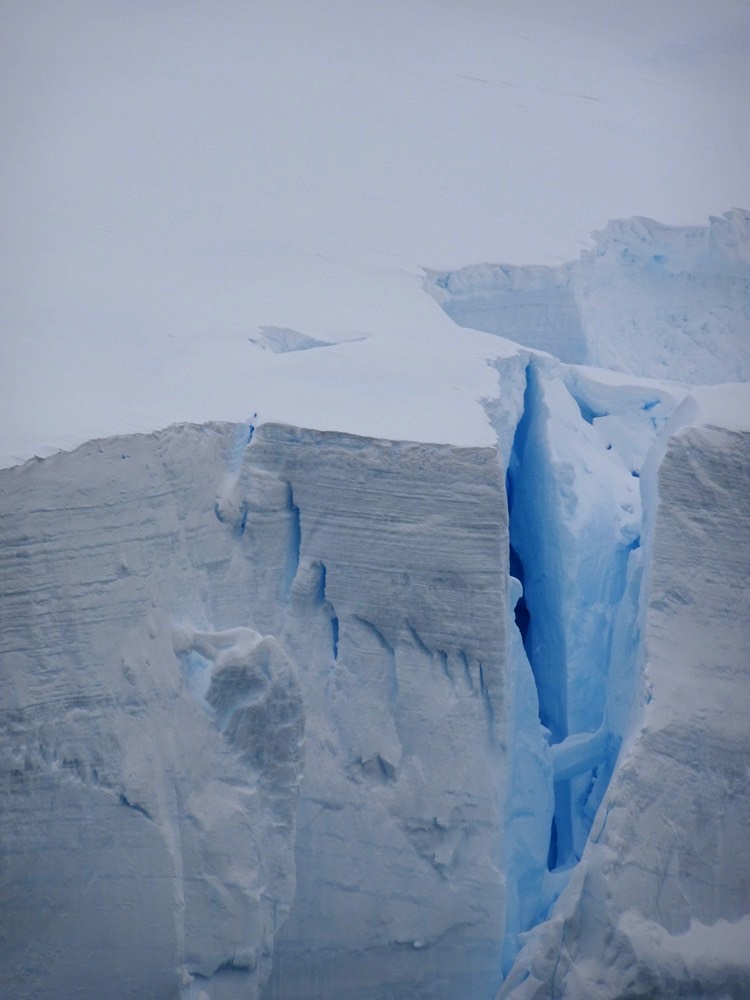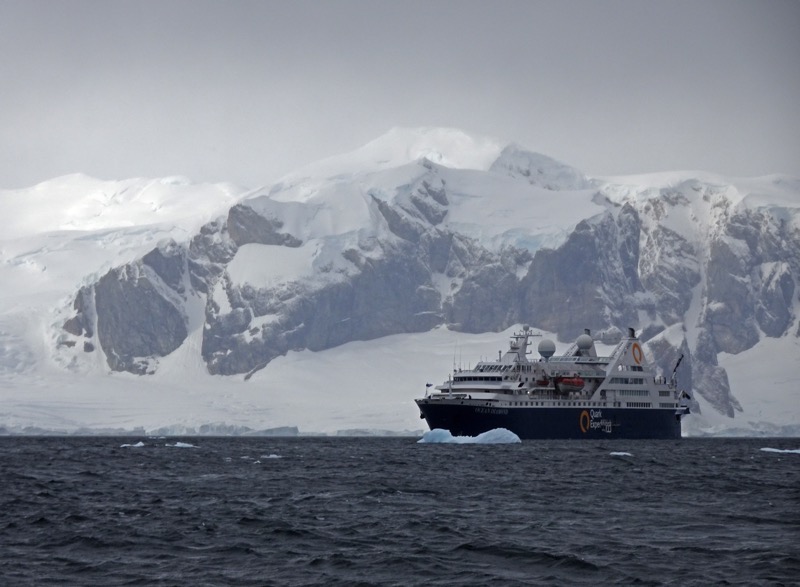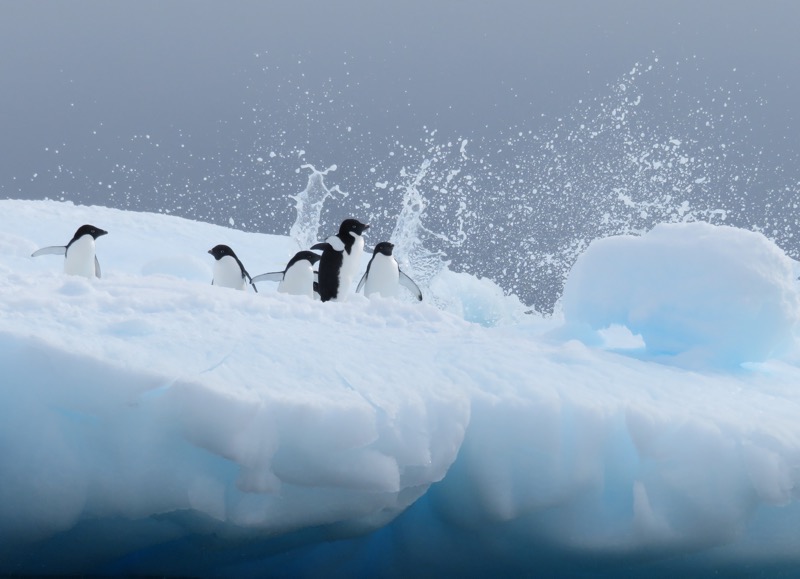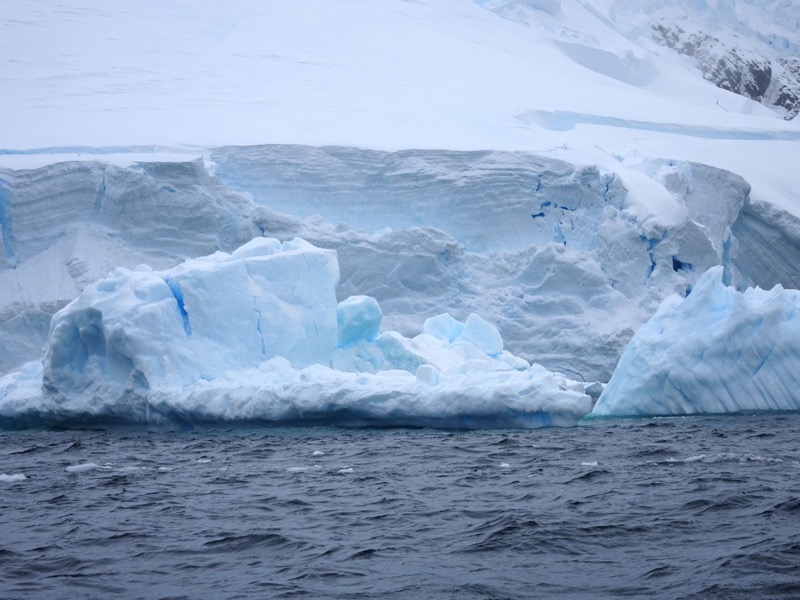“We must always remember with gratitude and admiration the first sailors who steered their vessels through storms and mists, and increased our knowledge of the lands of ice in the South.” ~ Roald Amundsen
Woke up this morning to the sound of everything on the desk hitting the floor. Thankfully it was only some jewellery, some sunglasses and a few other bits and pieces, but no cameras or laptops. The ship was really rocking and rolling, it was still snowing outside and the sea was, well… let’s just say it was finally showing some ‘character’. There were icebergs the size of office blocks outside our window and the crew were busy shovelling snow – yes, SHOVELLING snow off the upper decks.

We had hoped to be taking some zodiac excursions this morning to view icebergs and wildlife just inside Crystal Bay between Biscoe Island and Graham Land, but… the weather had other plans for us and we ended up going much further south into the sound until, about an hour and a half later, we eventually found a well-protected spot to go exploring.
We didn’t realize how quickly the zodiacs could be loaded and were told on the program that our zodiac group would be called about half an hour after the first two groups were called – but instead, we heard the announcement for the first groups, and a 15 minute, ‘arm and stand ready’ type call, for the second group and next thing we knew they were calling for last passengers when half of us barely had our Muck boots on, let alone the other twenty things you need to have on to leave the ship!
 Speaking of those damn Muck boots, I had a huge problem with the ones I was wearing yesterday in the form of them nearly cutting off the circulation to my feet. I mentioned when I picked them up that having tiny feet and not having skinny chicken legs is not exactly compatible with trying to wear boy’s sized boots and this was the result – rather unpleasant and painfully bruised shins from just one outing. I had to go back to Flipper (equipment logistics dude) to try and sort something out. They really have NO ladies boots on the ship and my only option was to go up another size to a men’s 6 – now two sizes too big for my tiny feet! – and put a couple of inner soles in the boots and wear thick socks and hope for the best! Only now I really do feel like I’m wearing clown shoes, my feet are slipping around inside the boots a lot, let alone slipping about outside on ice and rocks. I also lost all confidence in my ability to even navigate the stairs up and down to the gangway because I feel like I am walking around in yale’s shoes! Not ideal – had I known this was going to become such an issue I would have looked at buying suitable boots, hang the expense. :/ Nothing to be done though, but soldier on (very fucking carefully and slowly!) and hope I don’t take a tumble down a flight of stairs ruining the rest of the trip…
Speaking of those damn Muck boots, I had a huge problem with the ones I was wearing yesterday in the form of them nearly cutting off the circulation to my feet. I mentioned when I picked them up that having tiny feet and not having skinny chicken legs is not exactly compatible with trying to wear boy’s sized boots and this was the result – rather unpleasant and painfully bruised shins from just one outing. I had to go back to Flipper (equipment logistics dude) to try and sort something out. They really have NO ladies boots on the ship and my only option was to go up another size to a men’s 6 – now two sizes too big for my tiny feet! – and put a couple of inner soles in the boots and wear thick socks and hope for the best! Only now I really do feel like I’m wearing clown shoes, my feet are slipping around inside the boots a lot, let alone slipping about outside on ice and rocks. I also lost all confidence in my ability to even navigate the stairs up and down to the gangway because I feel like I am walking around in yale’s shoes! Not ideal – had I known this was going to become such an issue I would have looked at buying suitable boots, hang the expense. :/ Nothing to be done though, but soldier on (very fucking carefully and slowly!) and hope I don’t take a tumble down a flight of stairs ruining the rest of the trip…
We raced down to the gangway still zipping up jackets and clicking on lifejackets as we hightailed it down the stairs as quickly as our big chunky clown boots would allow.


Once loaded into the zodiacs we were quickly shooting off across the water towards *the* most enormous icebergs and ice cliffs I could ever have imagined. The scale and grandeur of this place is hard to put into words, and most of the images we capture are completely without scale, so it is hard to communicate what the landscape before us truly looks like, let alone the feeling that this place evokes in the viewer. It is highly dramatic and like no other place I’ve ever been – from the huge cliffs of the ancient glacier faces to the deceptively sized icebergs that have broken away from these creeping rivers of ice as they move inexorably towards the oceans.
Surrounded by this indescribably immense and uninterrupted, otherworldly and fascinating, ancient wilderness makes you feel decidedly small, temporary and completely insignificant…
It’s very hard to communicate the vast monumental humongousness of it all, so I will let these photos try to speak for themselves; all too well aware that these representations convey not even a fraction of the enormity of this place.




 Penguin photos: Scotty
Penguin photos: Scotty

 We were many kilometres away from the iceberg pictured below – I would estimate that the portion we can see above water it is possibly as much as four times the size of Carindale Westfield shopping centre. The scale of everything we are seeing here is truly hard to wrap your head around – size and distance are very difficult to judge without trees, people or animals providing scale.
We were many kilometres away from the iceberg pictured below – I would estimate that the portion we can see above water it is possibly as much as four times the size of Carindale Westfield shopping centre. The scale of everything we are seeing here is truly hard to wrap your head around – size and distance are very difficult to judge without trees, people or animals providing scale. Photo: Rex
Photo: Rex





 One of Barry’s photos of this same iceberg with a zodiac in it for scale… note though, that the zodiacs are required to remain a minimum of 200m away or twice the estimated height of the iceberg (whichever is greater) for safety purposes in the event of ice calving – so you can imagine how tiny the little boat would look if it were actually anywhere near close to the base of this gigantic iceberg.
One of Barry’s photos of this same iceberg with a zodiac in it for scale… note though, that the zodiacs are required to remain a minimum of 200m away or twice the estimated height of the iceberg (whichever is greater) for safety purposes in the event of ice calving – so you can imagine how tiny the little boat would look if it were actually anywhere near close to the base of this gigantic iceberg. Photo: Linda
Photo: Linda These photos are of Andersen Island and Crystal Bay, so named for all the scientists that studied ice crystals here in the 1960s.
These photos are of Andersen Island and Crystal Bay, so named for all the scientists that studied ice crystals here in the 1960s.
After our excursion, we chattered excitedly as we all quickly got rid of all our wet weather gear and head down to lunch. It was a fabulous, if cold and snowy, morning out. Some group saw lots of seals, some saw a group of Minke whales, and some saw a few Adelie penguins. Everyone saw the enormously beautiful glacier on the Continent, the mountain of ice on Andersen Island and the indescribably beautiful and enormous icebergs that surrounded us.
After lunch, there was a lecture on microbiology with Ema – which I just didn’t feel I had the energy for, but I made sure I attended the later History lecture with Federico on the early Belgium Antarctic explorers.
Seriously – this may be the most amusing least boring history lecture ever, so give it a few minutes before you abandon the text and end up down “HERE”.
Belgian Antarctica Expeditions of 1896-1899
The South Shetland Islands were discovered in 1818 by one, William Smith, a British explorer which eventually led to the islands becoming a stronghold for sealing stations that harvested pelts and produced fur. The ‘Seal Rush’ that followed Smith’s explorations did not lead to not many purely exploration expeditions in the sub-Antarctic, they were primarily ‘for profit’ expeditions aimed at exploiting the seal resources.
In 1885, the 6th International Geographic Congress was held and a decision was made to focus on the exploration of Antarctica to study all possible branches of science, leading to the Exploring Age, whereupon we meet Adrien de Gerlache.
 Adrien de GERLACHE was born in Hasselt in Belgium, he had applied to be part of Neils’ NE passage expedition, but unfortunately, Neils died before he could complete his plans. Gerlache then decided to raise funds to do an exploration of his own. There was no national funding available at this time, as Belgium was engaged in expending resources in the Belgium Congo but Gerlache managed to get himself a sailing vessel in 1896, the Belgica (previously named the Patrica) with an auxiliary engine with a whopping 150hp motor.
Adrien de GERLACHE was born in Hasselt in Belgium, he had applied to be part of Neils’ NE passage expedition, but unfortunately, Neils died before he could complete his plans. Gerlache then decided to raise funds to do an exploration of his own. There was no national funding available at this time, as Belgium was engaged in expending resources in the Belgium Congo but Gerlache managed to get himself a sailing vessel in 1896, the Belgica (previously named the Patrica) with an auxiliary engine with a whopping 150hp motor.
He pulled together a motley international crew – most of them were unpaid and between them, they had no common language… and it is at this point the entire venture starts to sound like a comedy of errors.
Gerlache – Belgian, Captain and Lead Explorer
Georges Lecointe – Belgian, 2iC, Navigator and Astronomer
Roald Amundsen – Norwegian, First Mate
Frederick Cook – America, Doctor and Photographer
Emile Danco – Belgian, Studies in Magnetism
Emil Racoviță – Romanian, Biologist
Henry Arctowski – Polish, Geology, Oceanography and Meteorology
They departed for the Antarctic after two weeks of preparation in Rio de Janeiro, where they had acquired a cook. They then pushed south on 11th of November 1897 to Montevideo, whereupon said cook promptly quit, and they sacked some sailors.
They then went around to Punta Arenas in Southern Chile, where more sailors were sacked for insubordination and where they thankfully found a new cook. Their plan was to sail south to the Antarctic Peninsula area, and then head to the Ross Sea with a smaller party. From there, they were to send the ship to winter in Australia and then come back and pick up the small land party from the Ross Sea on the way back.
It took them two weeks longer to get to the Peninsula than they expected which caused them to abandon the plan of going to the Ross Sea shelf – so instead they returned to Ushuaia to try and get free coal from Argentinan Navy, where they lost another two weeks waiting on the free coal. The summer was rapidly fading now and things were not going well. Once they finally got their coal, they encountered yet another obstacle when they hit a reef in the Beagle Channel and had to dump their water supplies to lift the ship off the reef.
It was at this point that they met the Reverend Thomas Bridges who was working in Ushuaia writing a Yamana to English Dictionary… Frederick Cook, the expedition’s American doctor borrowed Bridge’s dictionary and didn’t return it. Eventually, Cook returned to the US and attempted to publish the dictionary under his own name! Nice guy.
They then stopped on Staten Island to get more fresh water – and found the Lighthouse at the End of the World – the site that inspired Jules Verne’s novel of the same name.
By now it was January 22nd and weather was getting worse. They had a man overboard incident during a fierce storm when a young sailor named Weincke who was trying to secure coal from the scuppers was swept overboard. They had nearly managed to pull him back onto the ship when Weincke, just let go from the cold. More misfortune for the Belgian expedition.
January 24th 1888 and they finally started their scientific expedition. They discovered the only insect that lives in the Antarctic, the Belgica Antarctica – which is a flightless midgee adapted to the frigid environment. They also discovered the waterway that goes between the Antarctic Peninsula and the Palmer archipelago – which was eventually named the Galache strait.
“The night… fixes my attention and makes sleep impossible. There is a glitter in the sea, a sparkle on the ice, and stillness in the atmosphere… a solitude and restfulness about the whole scene which can only be felt; it cannot be described…” ~ from Gerlache’s log.
They did the first dog sledging journeys in Antarctica, and this, they paved the road for explorers for many explorers to come. They managed to sail through the Neumayer Chanel, named after an earlier German Explorer and named a small island there, Wiencke – after the young sailor who was lost.
They became the first explorers to sail through the Errera Chanel and then onto another channel named the Lemaire Channel, which had been previously discovered by Germans in 1874 but these Belgians were the first to traverse it.

The Belgica at anchor near Mt William, 1898
By this time they were considering the expedition to be most successful in its mapping and charting endeavours – but Gerlache wanted more, and they made their way down to cross the Antartic Circle and they ended up at Alexandre Island. Secretly the idiot commander wanted to be the first person to spend a winter below the Circle. By the time he said he ‘wanted’ to leave on March 4th, the ship was beset by ice and couldn’t get out even if he had actually wanted to.
By May 16th the long winter had set in and they would not see daylight again for over 70 days. The entire crew started to suffer from bad nutrition, depression, muscular convulsions, and various mental illnesses. Frederick Cook, the dictionary stealing doctor of the expedition took moral command (?) of the expedition and demanded they started eating seals and penguins to start getting some vitamin C into the crew to avoid scurvy. Apparently, it tasted bad – really bad – but in the absence of other supplies, it helped the men remain strong:
“It is rather difficult to describe its taste and appearance; we have absolutely no meat with which to compare it. The penguin, as an aminal, appears to be made up of an equal proportion of mammal, fish and foul. If it is possible to imagine a piece of beef, and odoriferous codfish and a canvasback duck roasted in a pot with blood and cod-liver oil for sauce, the illustration will be complete.” ~ Gerlache on eating penguins.
The forward-thinking Cook also instructed the men to stand in front of a stove for light each day ‘for their health’. With a decidedly weakened crew, a deceptive incompetent for a Captain, it was the experienced Norwegian, Amundsen who eventually took effective command of the expedition, as he was the strongest of the officers remaining. When the sun finally started to re-emerge, under Amundsen’s command they attempted to recommenced their scientific studies.
However, their ship, the Belgica remained stuck in the ice until well and truly mid-summer of ’98/’99 and the men were worried they were going to find themselves stranded for another winter – so they started to dig channels to try and free the ship. Eventually a more ambitious plan was hatched to dig a more substantial channel that would allow the ship to leave. The only one exempt from the digging efforts was the cook who was feeding the men constantly to keep them working 12 hours a day. Whenever they seemed close to freeing the ship, the ice would move and it would close the channel. Several men went mad during this period, including one Belgian sailor who literally walked away from the expedition into the wilderness saying he was going back to Belgium! After weeks of labor, they managed to get the ship off the ice by March 14th and went straight to Punta Arenas on March 28th.
Garlache was completely broke by their return and could not afford to buy more coal with which to continue with any future expeditions – if indeed he could have found any crew to sail with him. He eventually applied to get a whaling lease in the Antarctica but was not successful in being granted a license.
His next venture involved buying a called the Polaris to be used to lead ‘Antarctica Safaris’ for tourists, but that venture failed and he ended up selling the ship to Shackleton – the same ship that Shackleton renamed, Endurance and which was eventually crushed by ice in the Arctic. All up, Gerlache appears to have accomplished quite a lot with his expeditions, but not without significant cost to his crew.
“HERE”
After our history talk, it was Happy Hour at the bar…, and the ‘cocktail of the day’ was called – you would never have guessed it, an ‘Iceberg’ cocktail, made with vodka, blue curacao, and lemonade served over glacier ice! No shit, the zodiac guides all hunt for nice pieces of interestingly shaped or particularly clear chunks glacial ice which they fish out of the bay and out on the bar. So the bar staff were breaking up the 80,000-year-old ice to put in our cocktails.


 After cocktails and whatnot, we had our daily recap/debrief which was now seems to habitually be about letting us know where we hadn’t stuck to the program today, what the program is for tomorrow, and how to expect that are unlikely to stick to the program tomorrow either! We also have a general chat about the things we have seen today and other ship activities.
After cocktails and whatnot, we had our daily recap/debrief which was now seems to habitually be about letting us know where we hadn’t stuck to the program today, what the program is for tomorrow, and how to expect that are unlikely to stick to the program tomorrow either! We also have a general chat about the things we have seen today and other ship activities.
Not long after that it was yet another delicious dinner in the dining room, this time with Jean from the Expedition Team for company – Jean’s background is with 16 years in researching Adelie penguins in colonies near the Ross Sea and she is now ‘retired’ and spends November to March each year ‘not working’ on Quark’s ships sharing her passion for Antarctica. What a way to semi-retire!
Dinner was French onion soup, lamb-shanks and crepe Suzette… Gunter, the Austrian Executive Chef on board is totally spoiling us. Every meal has been just delicious.
Anyway, a cuppa, a port and bed time for me. Tomorrow we plan to zodiac cuise the Yalour Islands and then later do a landing and cruise excursion to Port Chacot… weather and conditions permitting of course!
